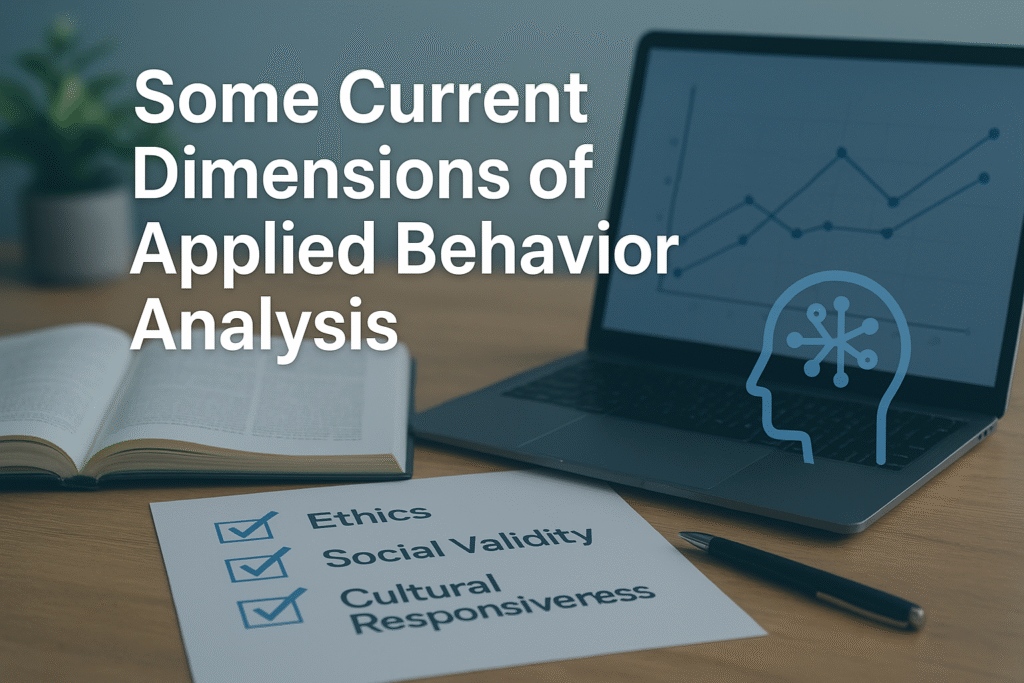Applied Behavior Analysis (ABA) has been shaping the way professionals understand and support human behavior for decades. When people talk about ABA, they often refer to the “7 dimensions” that guide its practice. But ABA is not frozen in time. Some current dimensions of applied behavior analysis go beyond the original framework, reflecting how the field has grown, adapted, and responded to new research and real-world needs.
Table of Contents

Whether you are studying for your RBT exam, practicing ABA in the field, or just learning how ABA works in daily life, understanding these updated dimensions is essential.
What Are the Dimensions of ABA?
At its core, ABA is a scientific approach to understanding behavior and how it changes. The original 7 dimensions of ABA were outlined in 1968 by Baer, Wolf, and Risley. These include being applied, behavioral, analytic, technological, conceptually systematic, effective, and generality.
However, today’s practitioners also consider additional, current dimensions such as ethical responsibility, cultural responsiveness, and socially valid outcomes. These newer dimensions don’t replace the original 7 but expand them to reflect modern ABA practice.
Learn more about the foundations of ABA on Wikipedia .
Some Current Dimensions of Applied Behavior Analysis
- Ethical Practice in ABA
Ethics has become a cornerstone of ABA in today’s world. Practitioners must follow strict professional guidelines set out by the BACB . These rules ensure that clients’ rights, dignity, and safety come first.
For RBT candidates, ethical practice is tested directly in the exam. Knowing how to handle real-life situations ethically is just as important as understanding behavioral principles.
- Cultural Responsiveness
ABA today is practiced in diverse communities across the globe. A current dimension of ABA is recognizing cultural differences and adapting strategies so they remain respectful and effective. This means being mindful of language, traditions, and family values when designing interventions.
- Social Validity
Social validity asks: Are the goals and methods of ABA meaningful to the person and their family? Modern ABA goes beyond just reducing problem behavior. It prioritizes outcomes that genuinely improve quality of life, such as communication skills, independence, and social connections.
- Data-Driven Accountability
While ABA has always relied on data, technology now makes it easier to track, measure, and analyze behavior. Apps and digital platforms allow for real-time data collection, making interventions more precise and transparent.
For students preparing for the rbt practice exam , understanding how data is collected and interpreted is crucial.
- Interdisciplinary Collaboration
Another current dimension is collaboration. ABA professionals now work closely with speech therapists, occupational therapists, educators, and families. This holistic approach ensures that behavior support plans align with other areas of development.
- Focus on Generalization and Maintenance
The original dimension of “generality” has evolved. Modern ABA emphasizes planning for generalization from the start of treatment, not as an afterthought. The goal is for skills to last beyond therapy sessions and across settings.
- Evidence-Based and Research-Driven
ABA continues to be grounded in science. Practitioners are expected to use interventions that are backed by peer-reviewed research. New studies in applied settings keep expanding the toolkit of evidence-based ABA strategies.
Why Do These Dimensions Matter for RBT Candidates?
If you’re preparing for the RBT exam, you’ll notice that these current dimensions show up in both direct questions and applied scenarios. For example:
You may be asked how to handle ethical dilemmas.
You’ll need to show an understanding of cultural factors when delivering services.
You’ll be expected to interpret data correctly and apply it to decision-making.
The best way to prepare is through practice. Taking a rbt mock test gives you real-world examples that strengthen your understanding of these principles.
PAA (People Also Ask) Friendly Q&A What are some current dimensions of applied behavior analysis?
They include ethical practice, cultural responsiveness, social validity, data-driven accountability, interdisciplinary collaboration, generalization planning, and evidence-based strategies.
How are the current dimensions different from the original 7 dimensions of ABA?
The original 7 dimensions remain foundational, but current dimensions expand on them by addressing ethics, cultural considerations, and meaningful outcomes for clients.
Why is social validity important in ABA?
Because it ensures that goals are personally valuable and interventions truly improve quality of life. Without social validity, ABA risks addressing behaviors that may not matter to the client.
How does cultural responsiveness fit into ABA?
Cultural responsiveness ensures that interventions respect and align with the client’s background, making behavior change more sustainable and meaningful.
How can I prepare for the RBT exam using these dimensions?
You can take a rbt practice test to get comfortable with how these dimensions appear in exam scenarios.
Practical Examples of Current Dimensions
Ethical practice: An RBT reporting concerns to a supervisor if a parent requests something outside ethical guidelines.
Cultural responsiveness: Using a family’s home language in visual aids.
Social validity: Setting goals that help a teenager make friends instead of focusing only on reducing stimming.
Data-driven accountability: Tracking how many times a child independently requests help during class.
Collaboration: An ABA therapist and speech therapist coordinating therapy goals.
These examples show that ABA today is not just about behavior reduction—it’s about building meaningful, respectful, and lasting change.
Conclusion
Some current dimensions of applied behavior analysis reflect how the field has grown beyond its original framework. By prioritizing ethics, cultural respect, social validity, collaboration, and evidence-based practice, ABA continues to make a meaningful impact.
If you’re preparing for your RBT exam, understanding these dimensions will help you both in testing and in real-world practice. Start strengthening your knowledge today with a rbt practice exam .yntax guide
